Report: Issues in Australian Screen Industry's Financing Model
VerifiedAdded on 2022/09/18
|12
|3069
|35
Report
AI Summary
This report delves into the financing and production model issues faced by the Australian screen industry. It identifies key challenges, including increasing taxation rates, debt financing complexities, and heightened competition from overseas film industries. The report analyzes the impact of these factors on the industry's profitability and sustainability. It examines the Australian government's tax structure, the various debt financing models used, and the influence of foreign films. The analysis highlights the difficulties faced by Australian production companies in securing funding, managing costs, and competing with international counterparts. The report concludes with recommendations for addressing these issues, such as foreign expansion and investment in technology. It emphasizes the need for strategic measures to ensure the long-term health and competitiveness of the Australian screen industry.

Running head: ISSUES IN AUSTRALIAN SCREEN INDUSTRY
Financing and Production Model Issues in the Australian Screen Industry
Name of the Student:
Name of the University:
Author Note:
Financing and Production Model Issues in the Australian Screen Industry
Name of the Student:
Name of the University:
Author Note:
Paraphrase This Document
Need a fresh take? Get an instant paraphrase of this document with our AI Paraphraser
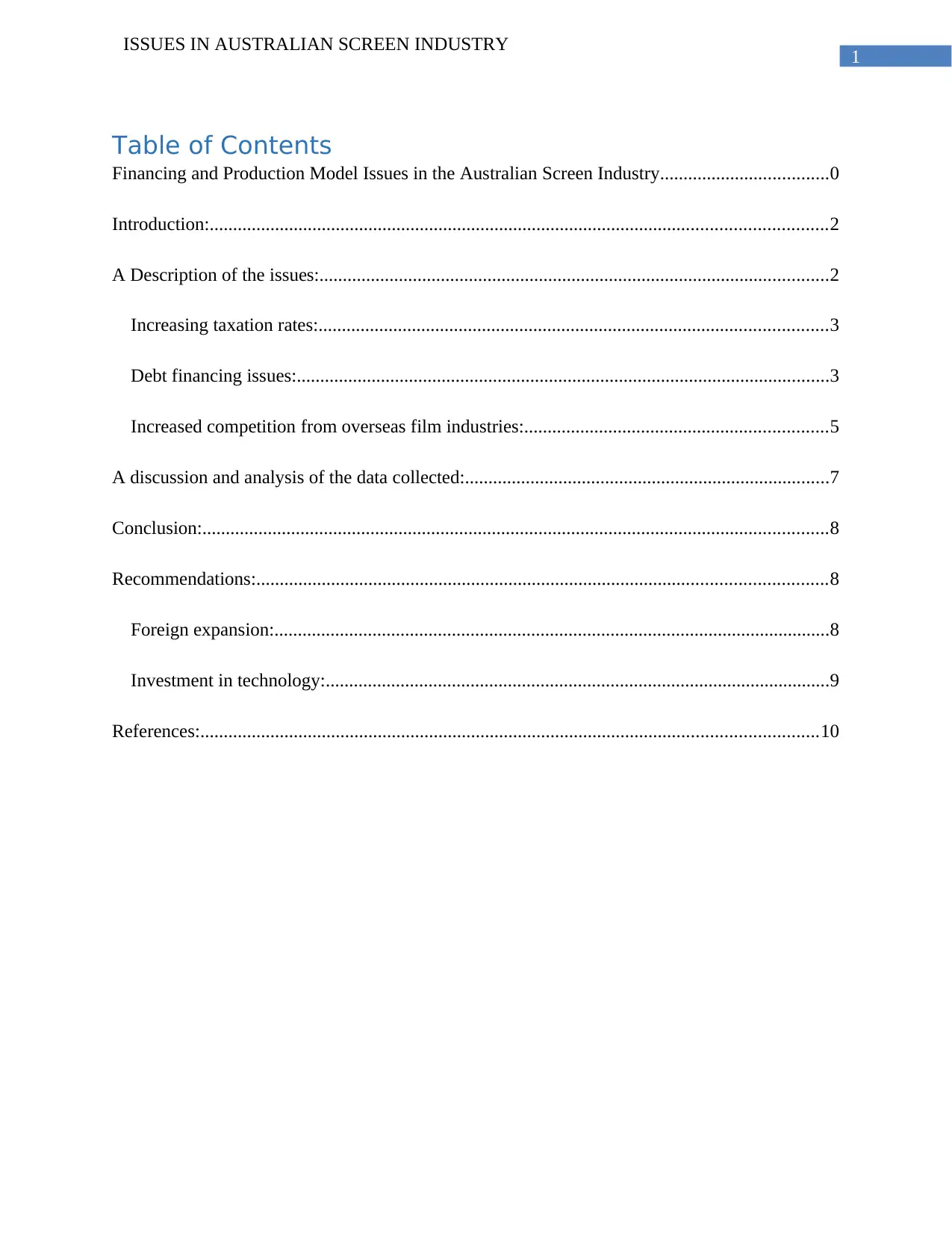
1
ISSUES IN AUSTRALIAN SCREEN INDUSTRY
Table of Contents
Financing and Production Model Issues in the Australian Screen Industry....................................0
Introduction:....................................................................................................................................2
A Description of the issues:.............................................................................................................2
Increasing taxation rates:.............................................................................................................3
Debt financing issues:..................................................................................................................3
Increased competition from overseas film industries:.................................................................5
A discussion and analysis of the data collected:..............................................................................7
Conclusion:......................................................................................................................................8
Recommendations:..........................................................................................................................8
Foreign expansion:.......................................................................................................................8
Investment in technology:............................................................................................................9
References:....................................................................................................................................10
ISSUES IN AUSTRALIAN SCREEN INDUSTRY
Table of Contents
Financing and Production Model Issues in the Australian Screen Industry....................................0
Introduction:....................................................................................................................................2
A Description of the issues:.............................................................................................................2
Increasing taxation rates:.............................................................................................................3
Debt financing issues:..................................................................................................................3
Increased competition from overseas film industries:.................................................................5
A discussion and analysis of the data collected:..............................................................................7
Conclusion:......................................................................................................................................8
Recommendations:..........................................................................................................................8
Foreign expansion:.......................................................................................................................8
Investment in technology:............................................................................................................9
References:....................................................................................................................................10
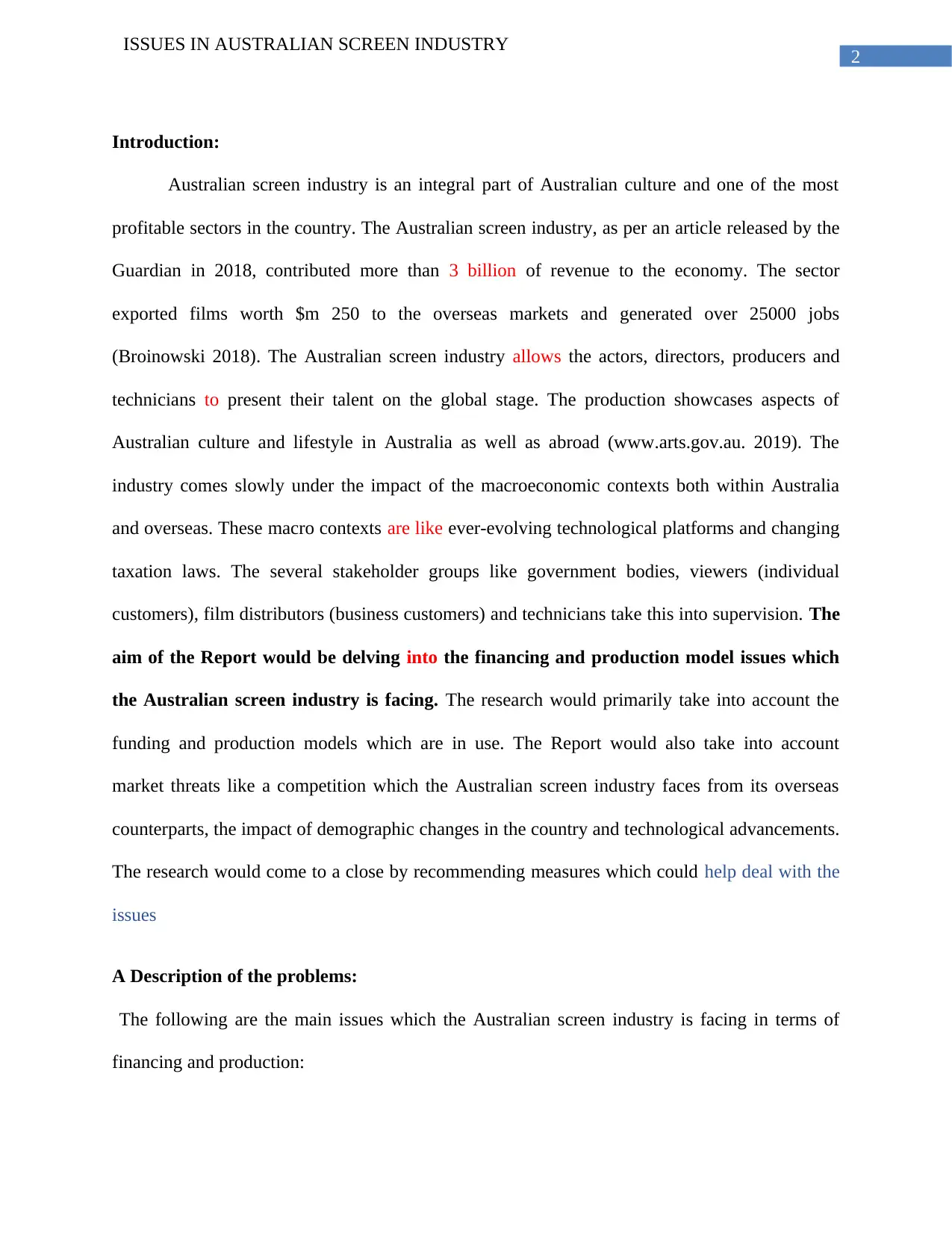
2
ISSUES IN AUSTRALIAN SCREEN INDUSTRY
Introduction:
Australian screen industry is an integral part of Australian culture and one of the most
profitable sectors in the country. The Australian screen industry, as per an article released by the
Guardian in 2018, contributed more than 3 billion of revenue to the economy. The sector
exported films worth $m 250 to the overseas markets and generated over 25000 jobs
(Broinowski 2018). The Australian screen industry allows the actors, directors, producers and
technicians to present their talent on the global stage. The production showcases aspects of
Australian culture and lifestyle in Australia as well as abroad (www.arts.gov.au. 2019). The
industry comes slowly under the impact of the macroeconomic contexts both within Australia
and overseas. These macro contexts are like ever-evolving technological platforms and changing
taxation laws. The several stakeholder groups like government bodies, viewers (individual
customers), film distributors (business customers) and technicians take this into supervision. The
aim of the Report would be delving into the financing and production model issues which
the Australian screen industry is facing. The research would primarily take into account the
funding and production models which are in use. The Report would also take into account
market threats like a competition which the Australian screen industry faces from its overseas
counterparts, the impact of demographic changes in the country and technological advancements.
The research would come to a close by recommending measures which could help deal with the
issues
A Description of the problems:
The following are the main issues which the Australian screen industry is facing in terms of
financing and production:
ISSUES IN AUSTRALIAN SCREEN INDUSTRY
Introduction:
Australian screen industry is an integral part of Australian culture and one of the most
profitable sectors in the country. The Australian screen industry, as per an article released by the
Guardian in 2018, contributed more than 3 billion of revenue to the economy. The sector
exported films worth $m 250 to the overseas markets and generated over 25000 jobs
(Broinowski 2018). The Australian screen industry allows the actors, directors, producers and
technicians to present their talent on the global stage. The production showcases aspects of
Australian culture and lifestyle in Australia as well as abroad (www.arts.gov.au. 2019). The
industry comes slowly under the impact of the macroeconomic contexts both within Australia
and overseas. These macro contexts are like ever-evolving technological platforms and changing
taxation laws. The several stakeholder groups like government bodies, viewers (individual
customers), film distributors (business customers) and technicians take this into supervision. The
aim of the Report would be delving into the financing and production model issues which
the Australian screen industry is facing. The research would primarily take into account the
funding and production models which are in use. The Report would also take into account
market threats like a competition which the Australian screen industry faces from its overseas
counterparts, the impact of demographic changes in the country and technological advancements.
The research would come to a close by recommending measures which could help deal with the
issues
A Description of the problems:
The following are the main issues which the Australian screen industry is facing in terms of
financing and production:
⊘ This is a preview!⊘
Do you want full access?
Subscribe today to unlock all pages.

Trusted by 1+ million students worldwide
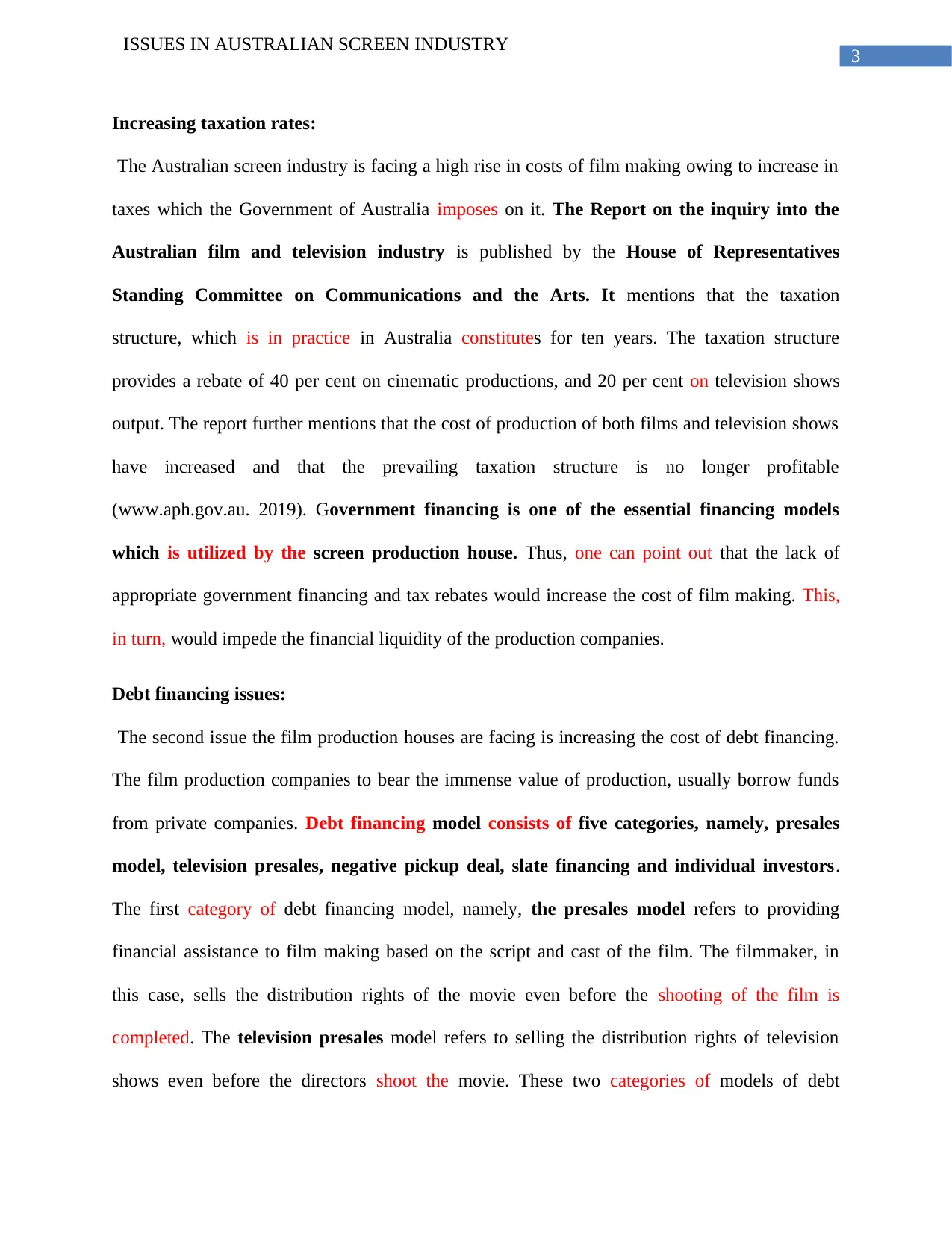
3
ISSUES IN AUSTRALIAN SCREEN INDUSTRY
Increasing taxation rates:
The Australian screen industry is facing a high rise in costs of film making owing to increase in
taxes which the Government of Australia imposes on it. The Report on the inquiry into the
Australian film and television industry is published by the House of Representatives
Standing Committee on Communications and the Arts. It mentions that the taxation
structure, which is in practice in Australia constitutes for ten years. The taxation structure
provides a rebate of 40 per cent on cinematic productions, and 20 per cent on television shows
output. The report further mentions that the cost of production of both films and television shows
have increased and that the prevailing taxation structure is no longer profitable
(www.aph.gov.au. 2019). Government financing is one of the essential financing models
which is utilized by the screen production house. Thus, one can point out that the lack of
appropriate government financing and tax rebates would increase the cost of film making. This,
in turn, would impede the financial liquidity of the production companies.
Debt financing issues:
The second issue the film production houses are facing is increasing the cost of debt financing.
The film production companies to bear the immense value of production, usually borrow funds
from private companies. Debt financing model consists of five categories, namely, presales
model, television presales, negative pickup deal, slate financing and individual investors.
The first category of debt financing model, namely, the presales model refers to providing
financial assistance to film making based on the script and cast of the film. The filmmaker, in
this case, sells the distribution rights of the movie even before the shooting of the film is
completed. The television presales model refers to selling the distribution rights of television
shows even before the directors shoot the movie. These two categories of models of debt
ISSUES IN AUSTRALIAN SCREEN INDUSTRY
Increasing taxation rates:
The Australian screen industry is facing a high rise in costs of film making owing to increase in
taxes which the Government of Australia imposes on it. The Report on the inquiry into the
Australian film and television industry is published by the House of Representatives
Standing Committee on Communications and the Arts. It mentions that the taxation
structure, which is in practice in Australia constitutes for ten years. The taxation structure
provides a rebate of 40 per cent on cinematic productions, and 20 per cent on television shows
output. The report further mentions that the cost of production of both films and television shows
have increased and that the prevailing taxation structure is no longer profitable
(www.aph.gov.au. 2019). Government financing is one of the essential financing models
which is utilized by the screen production house. Thus, one can point out that the lack of
appropriate government financing and tax rebates would increase the cost of film making. This,
in turn, would impede the financial liquidity of the production companies.
Debt financing issues:
The second issue the film production houses are facing is increasing the cost of debt financing.
The film production companies to bear the immense value of production, usually borrow funds
from private companies. Debt financing model consists of five categories, namely, presales
model, television presales, negative pickup deal, slate financing and individual investors.
The first category of debt financing model, namely, the presales model refers to providing
financial assistance to film making based on the script and cast of the film. The filmmaker, in
this case, sells the distribution rights of the movie even before the shooting of the film is
completed. The television presales model refers to selling the distribution rights of television
shows even before the directors shoot the movie. These two categories of models of debt
Paraphrase This Document
Need a fresh take? Get an instant paraphrase of this document with our AI Paraphraser
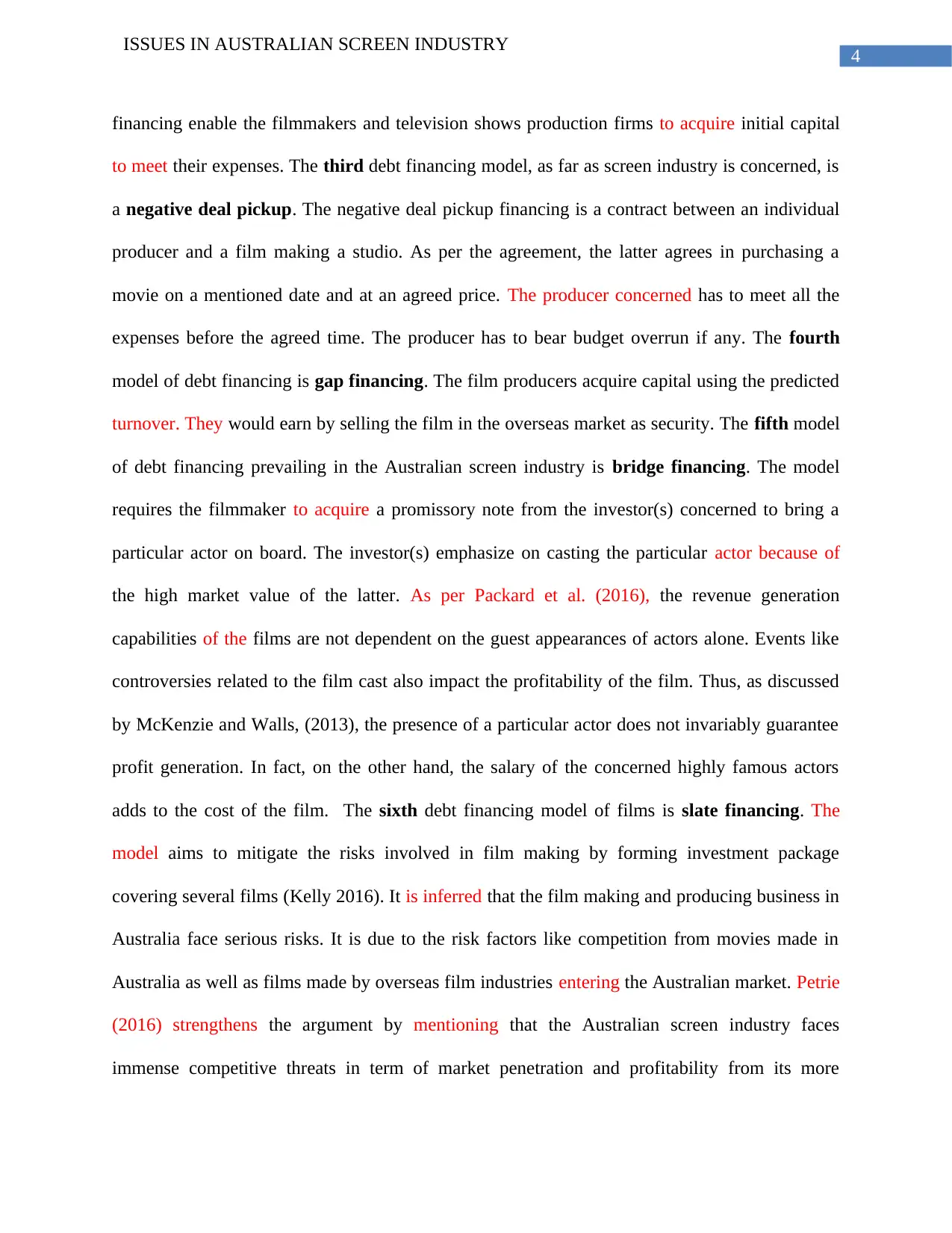
4
ISSUES IN AUSTRALIAN SCREEN INDUSTRY
financing enable the filmmakers and television shows production firms to acquire initial capital
to meet their expenses. The third debt financing model, as far as screen industry is concerned, is
a negative deal pickup. The negative deal pickup financing is a contract between an individual
producer and a film making a studio. As per the agreement, the latter agrees in purchasing a
movie on a mentioned date and at an agreed price. The producer concerned has to meet all the
expenses before the agreed time. The producer has to bear budget overrun if any. The fourth
model of debt financing is gap financing. The film producers acquire capital using the predicted
turnover. They would earn by selling the film in the overseas market as security. The fifth model
of debt financing prevailing in the Australian screen industry is bridge financing. The model
requires the filmmaker to acquire a promissory note from the investor(s) concerned to bring a
particular actor on board. The investor(s) emphasize on casting the particular actor because of
the high market value of the latter. As per Packard et al. (2016), the revenue generation
capabilities of the films are not dependent on the guest appearances of actors alone. Events like
controversies related to the film cast also impact the profitability of the film. Thus, as discussed
by McKenzie and Walls, (2013), the presence of a particular actor does not invariably guarantee
profit generation. In fact, on the other hand, the salary of the concerned highly famous actors
adds to the cost of the film. The sixth debt financing model of films is slate financing. The
model aims to mitigate the risks involved in film making by forming investment package
covering several films (Kelly 2016). It is inferred that the film making and producing business in
Australia face serious risks. It is due to the risk factors like competition from movies made in
Australia as well as films made by overseas film industries entering the Australian market. Petrie
(2016) strengthens the argument by mentioning that the Australian screen industry faces
immense competitive threats in term of market penetration and profitability from its more
ISSUES IN AUSTRALIAN SCREEN INDUSTRY
financing enable the filmmakers and television shows production firms to acquire initial capital
to meet their expenses. The third debt financing model, as far as screen industry is concerned, is
a negative deal pickup. The negative deal pickup financing is a contract between an individual
producer and a film making a studio. As per the agreement, the latter agrees in purchasing a
movie on a mentioned date and at an agreed price. The producer concerned has to meet all the
expenses before the agreed time. The producer has to bear budget overrun if any. The fourth
model of debt financing is gap financing. The film producers acquire capital using the predicted
turnover. They would earn by selling the film in the overseas market as security. The fifth model
of debt financing prevailing in the Australian screen industry is bridge financing. The model
requires the filmmaker to acquire a promissory note from the investor(s) concerned to bring a
particular actor on board. The investor(s) emphasize on casting the particular actor because of
the high market value of the latter. As per Packard et al. (2016), the revenue generation
capabilities of the films are not dependent on the guest appearances of actors alone. Events like
controversies related to the film cast also impact the profitability of the film. Thus, as discussed
by McKenzie and Walls, (2013), the presence of a particular actor does not invariably guarantee
profit generation. In fact, on the other hand, the salary of the concerned highly famous actors
adds to the cost of the film. The sixth debt financing model of films is slate financing. The
model aims to mitigate the risks involved in film making by forming investment package
covering several films (Kelly 2016). It is inferred that the film making and producing business in
Australia face serious risks. It is due to the risk factors like competition from movies made in
Australia as well as films made by overseas film industries entering the Australian market. Petrie
(2016) strengthens the argument by mentioning that the Australian screen industry faces
immense competitive threats in term of market penetration and profitability from its more
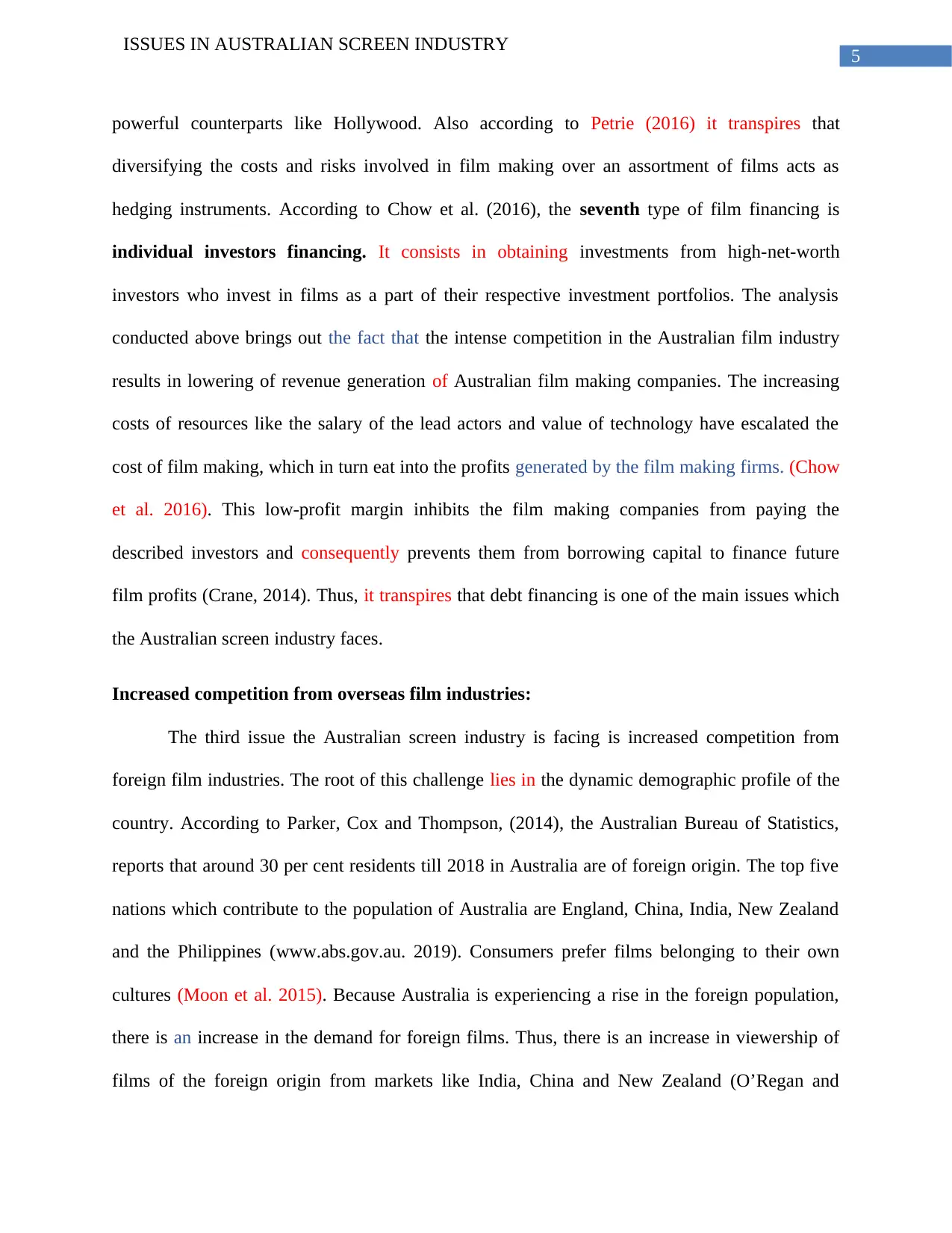
5
ISSUES IN AUSTRALIAN SCREEN INDUSTRY
powerful counterparts like Hollywood. Also according to Petrie (2016) it transpires that
diversifying the costs and risks involved in film making over an assortment of films acts as
hedging instruments. According to Chow et al. (2016), the seventh type of film financing is
individual investors financing. It consists in obtaining investments from high-net-worth
investors who invest in films as a part of their respective investment portfolios. The analysis
conducted above brings out the fact that the intense competition in the Australian film industry
results in lowering of revenue generation of Australian film making companies. The increasing
costs of resources like the salary of the lead actors and value of technology have escalated the
cost of film making, which in turn eat into the profits generated by the film making firms. (Chow
et al. 2016). This low-profit margin inhibits the film making companies from paying the
described investors and consequently prevents them from borrowing capital to finance future
film profits (Crane, 2014). Thus, it transpires that debt financing is one of the main issues which
the Australian screen industry faces.
Increased competition from overseas film industries:
The third issue the Australian screen industry is facing is increased competition from
foreign film industries. The root of this challenge lies in the dynamic demographic profile of the
country. According to Parker, Cox and Thompson, (2014), the Australian Bureau of Statistics,
reports that around 30 per cent residents till 2018 in Australia are of foreign origin. The top five
nations which contribute to the population of Australia are England, China, India, New Zealand
and the Philippines (www.abs.gov.au. 2019). Consumers prefer films belonging to their own
cultures (Moon et al. 2015). Because Australia is experiencing a rise in the foreign population,
there is an increase in the demand for foreign films. Thus, there is an increase in viewership of
films of the foreign origin from markets like India, China and New Zealand (O’Regan and
ISSUES IN AUSTRALIAN SCREEN INDUSTRY
powerful counterparts like Hollywood. Also according to Petrie (2016) it transpires that
diversifying the costs and risks involved in film making over an assortment of films acts as
hedging instruments. According to Chow et al. (2016), the seventh type of film financing is
individual investors financing. It consists in obtaining investments from high-net-worth
investors who invest in films as a part of their respective investment portfolios. The analysis
conducted above brings out the fact that the intense competition in the Australian film industry
results in lowering of revenue generation of Australian film making companies. The increasing
costs of resources like the salary of the lead actors and value of technology have escalated the
cost of film making, which in turn eat into the profits generated by the film making firms. (Chow
et al. 2016). This low-profit margin inhibits the film making companies from paying the
described investors and consequently prevents them from borrowing capital to finance future
film profits (Crane, 2014). Thus, it transpires that debt financing is one of the main issues which
the Australian screen industry faces.
Increased competition from overseas film industries:
The third issue the Australian screen industry is facing is increased competition from
foreign film industries. The root of this challenge lies in the dynamic demographic profile of the
country. According to Parker, Cox and Thompson, (2014), the Australian Bureau of Statistics,
reports that around 30 per cent residents till 2018 in Australia are of foreign origin. The top five
nations which contribute to the population of Australia are England, China, India, New Zealand
and the Philippines (www.abs.gov.au. 2019). Consumers prefer films belonging to their own
cultures (Moon et al. 2015). Because Australia is experiencing a rise in the foreign population,
there is an increase in the demand for foreign films. Thus, there is an increase in viewership of
films of the foreign origin from markets like India, China and New Zealand (O’Regan and
⊘ This is a preview!⊘
Do you want full access?
Subscribe today to unlock all pages.

Trusted by 1+ million students worldwide
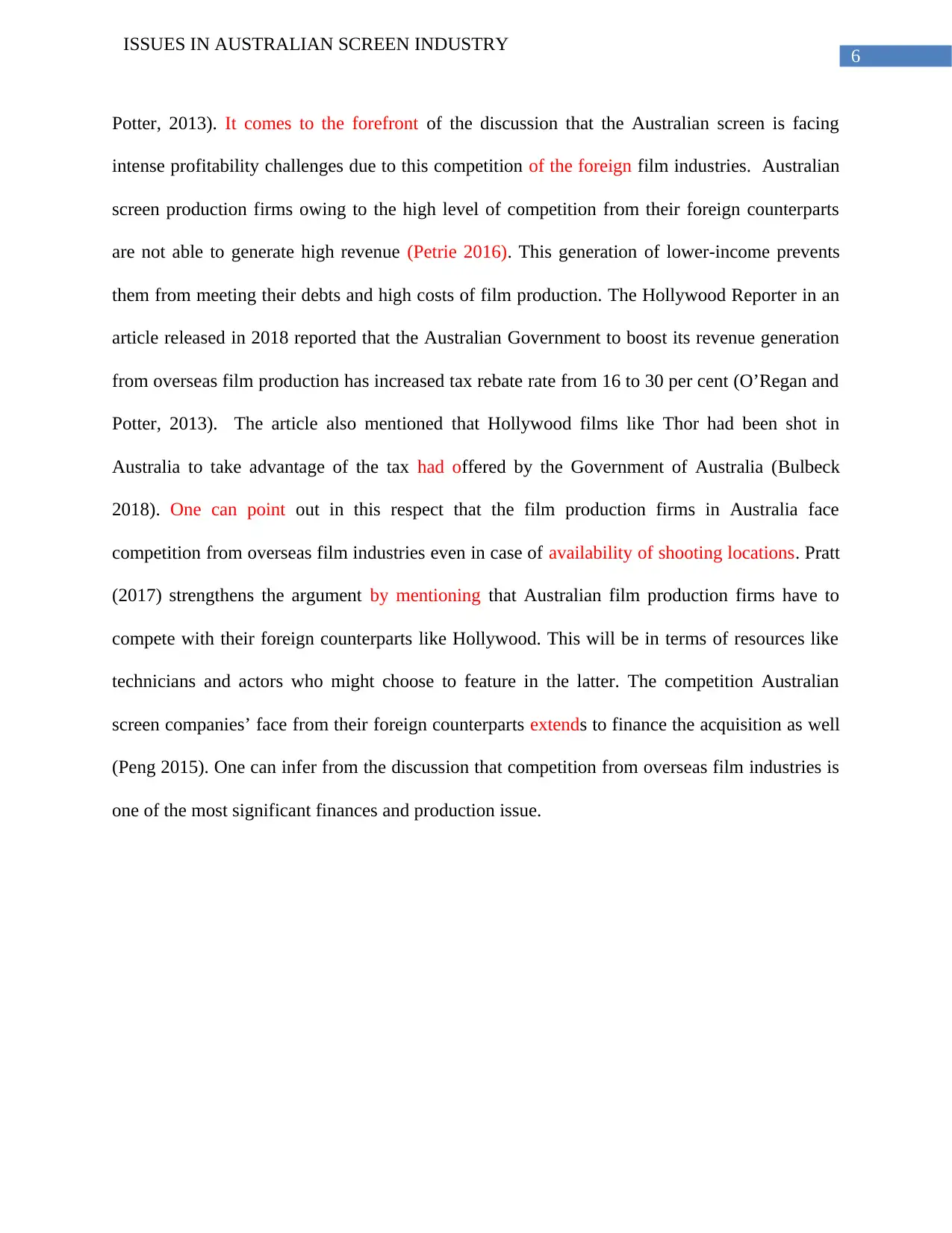
6
ISSUES IN AUSTRALIAN SCREEN INDUSTRY
Potter, 2013). It comes to the forefront of the discussion that the Australian screen is facing
intense profitability challenges due to this competition of the foreign film industries. Australian
screen production firms owing to the high level of competition from their foreign counterparts
are not able to generate high revenue (Petrie 2016). This generation of lower-income prevents
them from meeting their debts and high costs of film production. The Hollywood Reporter in an
article released in 2018 reported that the Australian Government to boost its revenue generation
from overseas film production has increased tax rebate rate from 16 to 30 per cent (O’Regan and
Potter, 2013). The article also mentioned that Hollywood films like Thor had been shot in
Australia to take advantage of the tax had offered by the Government of Australia (Bulbeck
2018). One can point out in this respect that the film production firms in Australia face
competition from overseas film industries even in case of availability of shooting locations. Pratt
(2017) strengthens the argument by mentioning that Australian film production firms have to
compete with their foreign counterparts like Hollywood. This will be in terms of resources like
technicians and actors who might choose to feature in the latter. The competition Australian
screen companies’ face from their foreign counterparts extends to finance the acquisition as well
(Peng 2015). One can infer from the discussion that competition from overseas film industries is
one of the most significant finances and production issue.
ISSUES IN AUSTRALIAN SCREEN INDUSTRY
Potter, 2013). It comes to the forefront of the discussion that the Australian screen is facing
intense profitability challenges due to this competition of the foreign film industries. Australian
screen production firms owing to the high level of competition from their foreign counterparts
are not able to generate high revenue (Petrie 2016). This generation of lower-income prevents
them from meeting their debts and high costs of film production. The Hollywood Reporter in an
article released in 2018 reported that the Australian Government to boost its revenue generation
from overseas film production has increased tax rebate rate from 16 to 30 per cent (O’Regan and
Potter, 2013). The article also mentioned that Hollywood films like Thor had been shot in
Australia to take advantage of the tax had offered by the Government of Australia (Bulbeck
2018). One can point out in this respect that the film production firms in Australia face
competition from overseas film industries even in case of availability of shooting locations. Pratt
(2017) strengthens the argument by mentioning that Australian film production firms have to
compete with their foreign counterparts like Hollywood. This will be in terms of resources like
technicians and actors who might choose to feature in the latter. The competition Australian
screen companies’ face from their foreign counterparts extends to finance the acquisition as well
(Peng 2015). One can infer from the discussion that competition from overseas film industries is
one of the most significant finances and production issue.
Paraphrase This Document
Need a fresh take? Get an instant paraphrase of this document with our AI Paraphraser
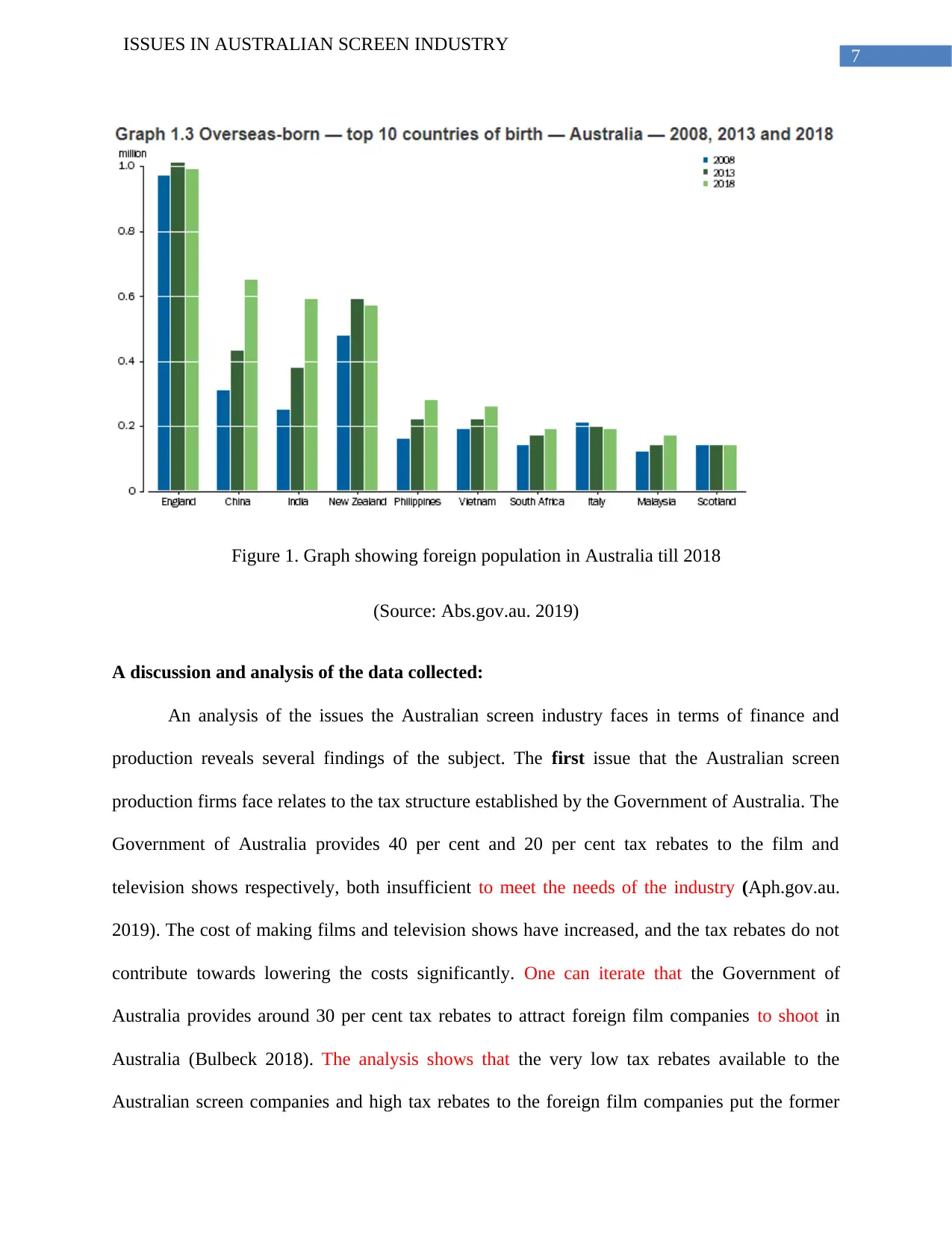
7
ISSUES IN AUSTRALIAN SCREEN INDUSTRY
Figure 1. Graph showing foreign population in Australia till 2018
(Source: Abs.gov.au. 2019)
A discussion and analysis of the data collected:
An analysis of the issues the Australian screen industry faces in terms of finance and
production reveals several findings of the subject. The first issue that the Australian screen
production firms face relates to the tax structure established by the Government of Australia. The
Government of Australia provides 40 per cent and 20 per cent tax rebates to the film and
television shows respectively, both insufficient to meet the needs of the industry (Aph.gov.au.
2019). The cost of making films and television shows have increased, and the tax rebates do not
contribute towards lowering the costs significantly. One can iterate that the Government of
Australia provides around 30 per cent tax rebates to attract foreign film companies to shoot in
Australia (Bulbeck 2018). The analysis shows that the very low tax rebates available to the
Australian screen companies and high tax rebates to the foreign film companies put the former
ISSUES IN AUSTRALIAN SCREEN INDUSTRY
Figure 1. Graph showing foreign population in Australia till 2018
(Source: Abs.gov.au. 2019)
A discussion and analysis of the data collected:
An analysis of the issues the Australian screen industry faces in terms of finance and
production reveals several findings of the subject. The first issue that the Australian screen
production firms face relates to the tax structure established by the Government of Australia. The
Government of Australia provides 40 per cent and 20 per cent tax rebates to the film and
television shows respectively, both insufficient to meet the needs of the industry (Aph.gov.au.
2019). The cost of making films and television shows have increased, and the tax rebates do not
contribute towards lowering the costs significantly. One can iterate that the Government of
Australia provides around 30 per cent tax rebates to attract foreign film companies to shoot in
Australia (Bulbeck 2018). The analysis shows that the very low tax rebates available to the
Australian screen companies and high tax rebates to the foreign film companies put the former
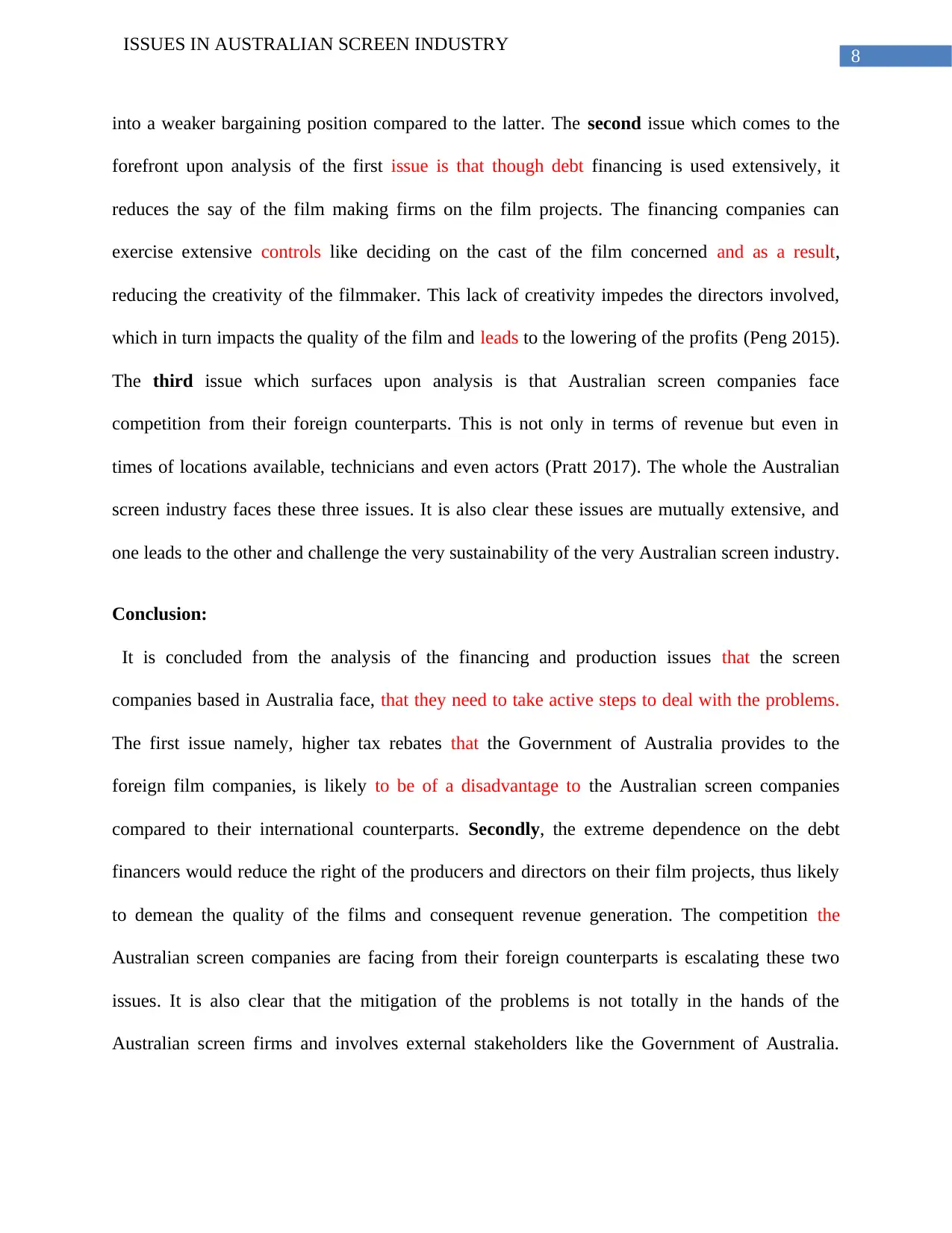
8
ISSUES IN AUSTRALIAN SCREEN INDUSTRY
into a weaker bargaining position compared to the latter. The second issue which comes to the
forefront upon analysis of the first issue is that though debt financing is used extensively, it
reduces the say of the film making firms on the film projects. The financing companies can
exercise extensive controls like deciding on the cast of the film concerned and as a result,
reducing the creativity of the filmmaker. This lack of creativity impedes the directors involved,
which in turn impacts the quality of the film and leads to the lowering of the profits (Peng 2015).
The third issue which surfaces upon analysis is that Australian screen companies face
competition from their foreign counterparts. This is not only in terms of revenue but even in
times of locations available, technicians and even actors (Pratt 2017). The whole the Australian
screen industry faces these three issues. It is also clear these issues are mutually extensive, and
one leads to the other and challenge the very sustainability of the very Australian screen industry.
Conclusion:
It is concluded from the analysis of the financing and production issues that the screen
companies based in Australia face, that they need to take active steps to deal with the problems.
The first issue namely, higher tax rebates that the Government of Australia provides to the
foreign film companies, is likely to be of a disadvantage to the Australian screen companies
compared to their international counterparts. Secondly, the extreme dependence on the debt
financers would reduce the right of the producers and directors on their film projects, thus likely
to demean the quality of the films and consequent revenue generation. The competition the
Australian screen companies are facing from their foreign counterparts is escalating these two
issues. It is also clear that the mitigation of the problems is not totally in the hands of the
Australian screen firms and involves external stakeholders like the Government of Australia.
ISSUES IN AUSTRALIAN SCREEN INDUSTRY
into a weaker bargaining position compared to the latter. The second issue which comes to the
forefront upon analysis of the first issue is that though debt financing is used extensively, it
reduces the say of the film making firms on the film projects. The financing companies can
exercise extensive controls like deciding on the cast of the film concerned and as a result,
reducing the creativity of the filmmaker. This lack of creativity impedes the directors involved,
which in turn impacts the quality of the film and leads to the lowering of the profits (Peng 2015).
The third issue which surfaces upon analysis is that Australian screen companies face
competition from their foreign counterparts. This is not only in terms of revenue but even in
times of locations available, technicians and even actors (Pratt 2017). The whole the Australian
screen industry faces these three issues. It is also clear these issues are mutually extensive, and
one leads to the other and challenge the very sustainability of the very Australian screen industry.
Conclusion:
It is concluded from the analysis of the financing and production issues that the screen
companies based in Australia face, that they need to take active steps to deal with the problems.
The first issue namely, higher tax rebates that the Government of Australia provides to the
foreign film companies, is likely to be of a disadvantage to the Australian screen companies
compared to their international counterparts. Secondly, the extreme dependence on the debt
financers would reduce the right of the producers and directors on their film projects, thus likely
to demean the quality of the films and consequent revenue generation. The competition the
Australian screen companies are facing from their foreign counterparts is escalating these two
issues. It is also clear that the mitigation of the problems is not totally in the hands of the
Australian screen firms and involves external stakeholders like the Government of Australia.
⊘ This is a preview!⊘
Do you want full access?
Subscribe today to unlock all pages.

Trusted by 1+ million students worldwide
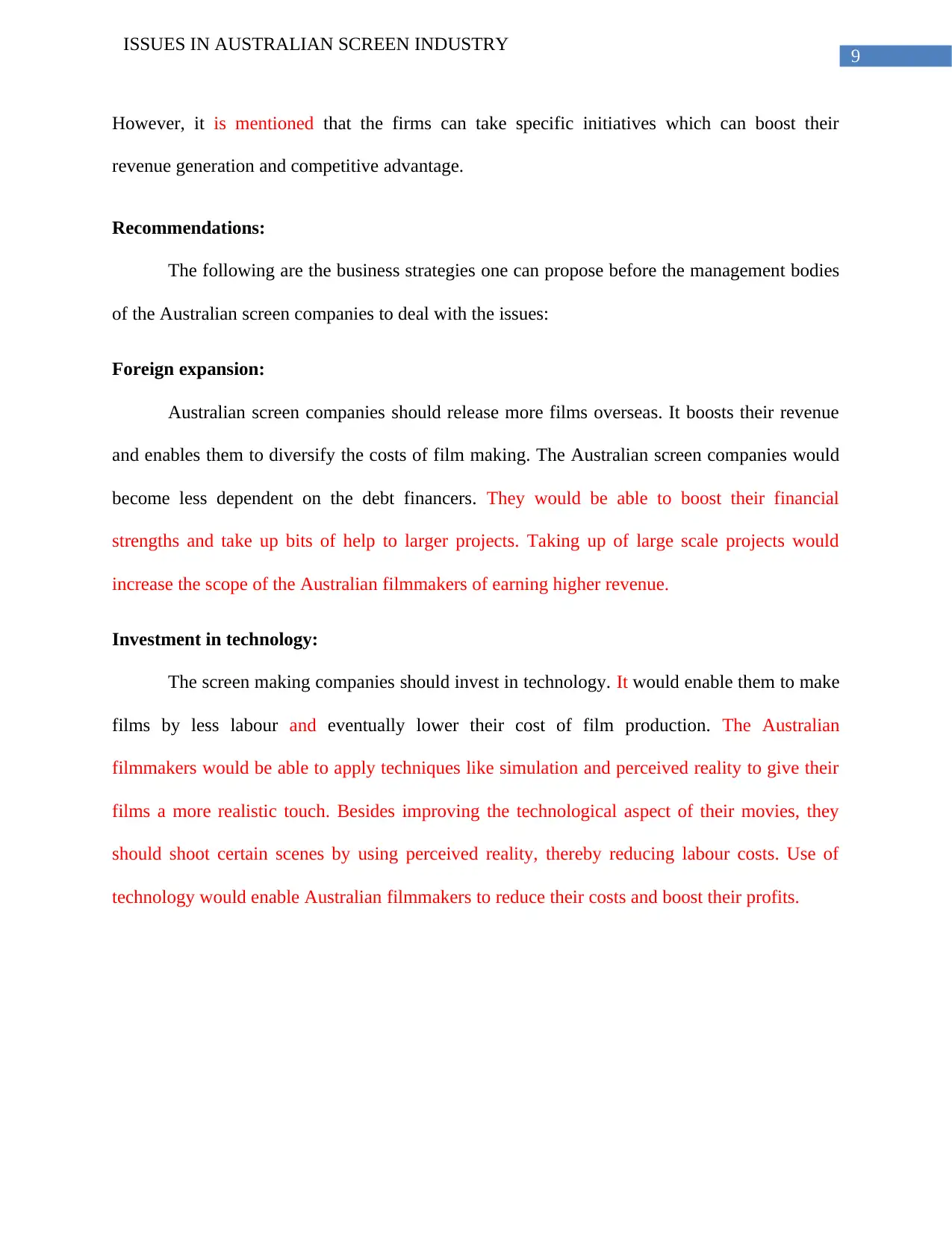
9
ISSUES IN AUSTRALIAN SCREEN INDUSTRY
However, it is mentioned that the firms can take specific initiatives which can boost their
revenue generation and competitive advantage.
Recommendations:
The following are the business strategies one can propose before the management bodies
of the Australian screen companies to deal with the issues:
Foreign expansion:
Australian screen companies should release more films overseas. It boosts their revenue
and enables them to diversify the costs of film making. The Australian screen companies would
become less dependent on the debt financers. They would be able to boost their financial
strengths and take up bits of help to larger projects. Taking up of large scale projects would
increase the scope of the Australian filmmakers of earning higher revenue.
Investment in technology:
The screen making companies should invest in technology. It would enable them to make
films by less labour and eventually lower their cost of film production. The Australian
filmmakers would be able to apply techniques like simulation and perceived reality to give their
films a more realistic touch. Besides improving the technological aspect of their movies, they
should shoot certain scenes by using perceived reality, thereby reducing labour costs. Use of
technology would enable Australian filmmakers to reduce their costs and boost their profits.
ISSUES IN AUSTRALIAN SCREEN INDUSTRY
However, it is mentioned that the firms can take specific initiatives which can boost their
revenue generation and competitive advantage.
Recommendations:
The following are the business strategies one can propose before the management bodies
of the Australian screen companies to deal with the issues:
Foreign expansion:
Australian screen companies should release more films overseas. It boosts their revenue
and enables them to diversify the costs of film making. The Australian screen companies would
become less dependent on the debt financers. They would be able to boost their financial
strengths and take up bits of help to larger projects. Taking up of large scale projects would
increase the scope of the Australian filmmakers of earning higher revenue.
Investment in technology:
The screen making companies should invest in technology. It would enable them to make
films by less labour and eventually lower their cost of film production. The Australian
filmmakers would be able to apply techniques like simulation and perceived reality to give their
films a more realistic touch. Besides improving the technological aspect of their movies, they
should shoot certain scenes by using perceived reality, thereby reducing labour costs. Use of
technology would enable Australian filmmakers to reduce their costs and boost their profits.
Paraphrase This Document
Need a fresh take? Get an instant paraphrase of this document with our AI Paraphraser
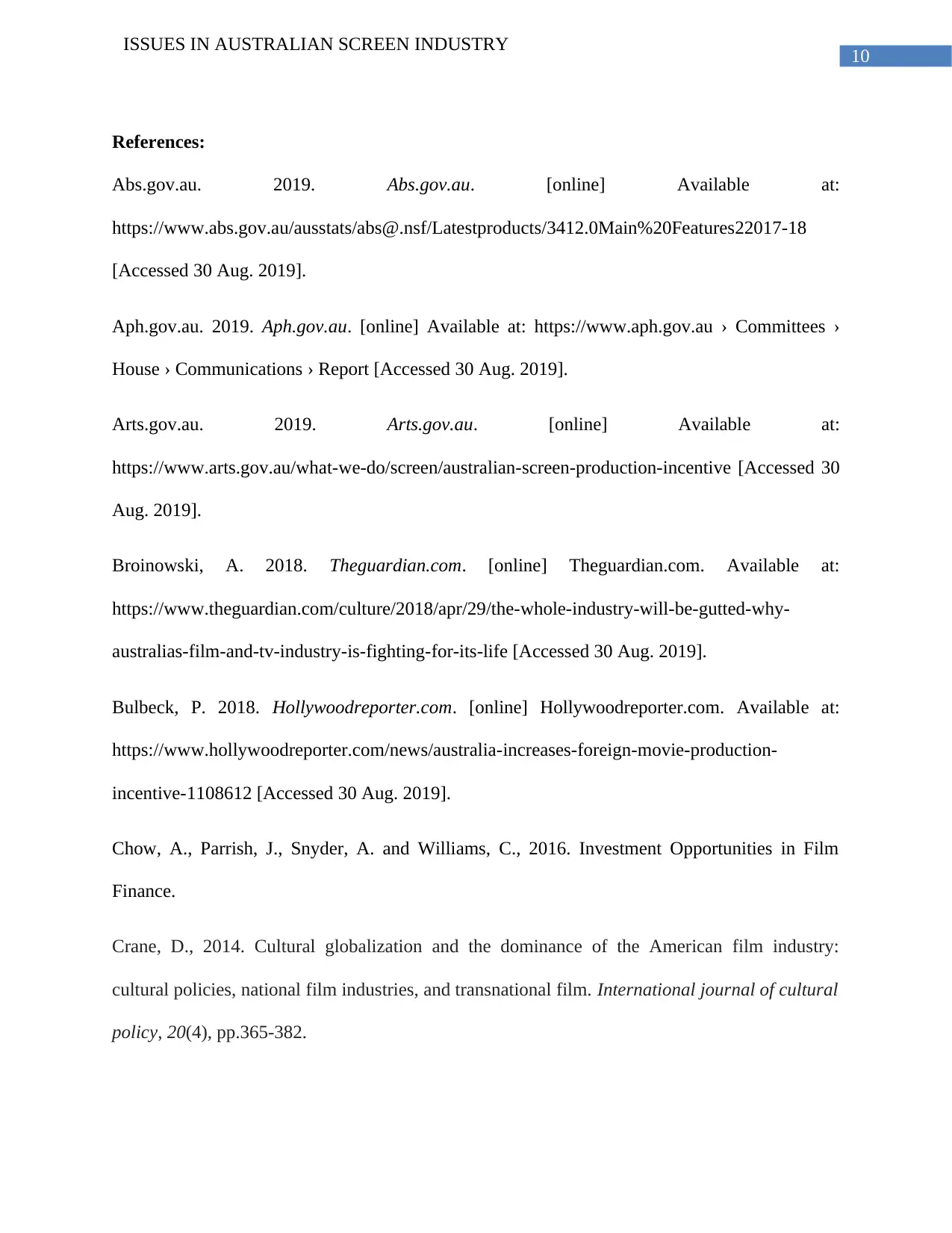
10
ISSUES IN AUSTRALIAN SCREEN INDUSTRY
References:
Abs.gov.au. 2019. Abs.gov.au. [online] Available at:
https://www.abs.gov.au/ausstats/abs@.nsf/Latestproducts/3412.0Main%20Features22017-18
[Accessed 30 Aug. 2019].
Aph.gov.au. 2019. Aph.gov.au. [online] Available at: https://www.aph.gov.au › Committees ›
House › Communications › Report [Accessed 30 Aug. 2019].
Arts.gov.au. 2019. Arts.gov.au. [online] Available at:
https://www.arts.gov.au/what-we-do/screen/australian-screen-production-incentive [Accessed 30
Aug. 2019].
Broinowski, A. 2018. Theguardian.com. [online] Theguardian.com. Available at:
https://www.theguardian.com/culture/2018/apr/29/the-whole-industry-will-be-gutted-why-
australias-film-and-tv-industry-is-fighting-for-its-life [Accessed 30 Aug. 2019].
Bulbeck, P. 2018. Hollywoodreporter.com. [online] Hollywoodreporter.com. Available at:
https://www.hollywoodreporter.com/news/australia-increases-foreign-movie-production-
incentive-1108612 [Accessed 30 Aug. 2019].
Chow, A., Parrish, J., Snyder, A. and Williams, C., 2016. Investment Opportunities in Film
Finance.
Crane, D., 2014. Cultural globalization and the dominance of the American film industry:
cultural policies, national film industries, and transnational film. International journal of cultural
policy, 20(4), pp.365-382.
ISSUES IN AUSTRALIAN SCREEN INDUSTRY
References:
Abs.gov.au. 2019. Abs.gov.au. [online] Available at:
https://www.abs.gov.au/ausstats/abs@.nsf/Latestproducts/3412.0Main%20Features22017-18
[Accessed 30 Aug. 2019].
Aph.gov.au. 2019. Aph.gov.au. [online] Available at: https://www.aph.gov.au › Committees ›
House › Communications › Report [Accessed 30 Aug. 2019].
Arts.gov.au. 2019. Arts.gov.au. [online] Available at:
https://www.arts.gov.au/what-we-do/screen/australian-screen-production-incentive [Accessed 30
Aug. 2019].
Broinowski, A. 2018. Theguardian.com. [online] Theguardian.com. Available at:
https://www.theguardian.com/culture/2018/apr/29/the-whole-industry-will-be-gutted-why-
australias-film-and-tv-industry-is-fighting-for-its-life [Accessed 30 Aug. 2019].
Bulbeck, P. 2018. Hollywoodreporter.com. [online] Hollywoodreporter.com. Available at:
https://www.hollywoodreporter.com/news/australia-increases-foreign-movie-production-
incentive-1108612 [Accessed 30 Aug. 2019].
Chow, A., Parrish, J., Snyder, A. and Williams, C., 2016. Investment Opportunities in Film
Finance.
Crane, D., 2014. Cultural globalization and the dominance of the American film industry:
cultural policies, national film industries, and transnational film. International journal of cultural
policy, 20(4), pp.365-382.
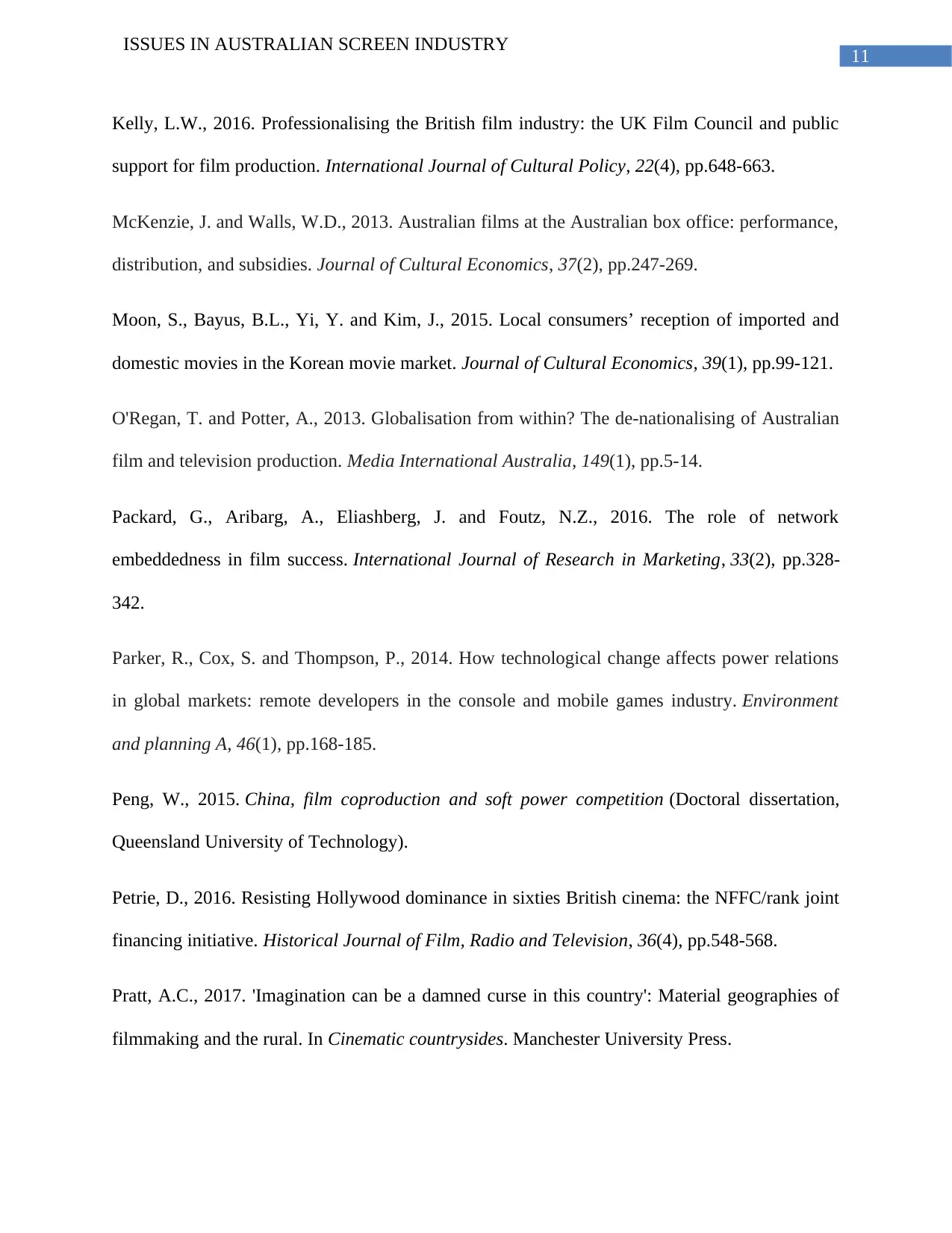
11
ISSUES IN AUSTRALIAN SCREEN INDUSTRY
Kelly, L.W., 2016. Professionalising the British film industry: the UK Film Council and public
support for film production. International Journal of Cultural Policy, 22(4), pp.648-663.
McKenzie, J. and Walls, W.D., 2013. Australian films at the Australian box office: performance,
distribution, and subsidies. Journal of Cultural Economics, 37(2), pp.247-269.
Moon, S., Bayus, B.L., Yi, Y. and Kim, J., 2015. Local consumers’ reception of imported and
domestic movies in the Korean movie market. Journal of Cultural Economics, 39(1), pp.99-121.
O'Regan, T. and Potter, A., 2013. Globalisation from within? The de-nationalising of Australian
film and television production. Media International Australia, 149(1), pp.5-14.
Packard, G., Aribarg, A., Eliashberg, J. and Foutz, N.Z., 2016. The role of network
embeddedness in film success. International Journal of Research in Marketing, 33(2), pp.328-
342.
Parker, R., Cox, S. and Thompson, P., 2014. How technological change affects power relations
in global markets: remote developers in the console and mobile games industry. Environment
and planning A, 46(1), pp.168-185.
Peng, W., 2015. China, film coproduction and soft power competition (Doctoral dissertation,
Queensland University of Technology).
Petrie, D., 2016. Resisting Hollywood dominance in sixties British cinema: the NFFC/rank joint
financing initiative. Historical Journal of Film, Radio and Television, 36(4), pp.548-568.
Pratt, A.C., 2017. 'Imagination can be a damned curse in this country': Material geographies of
filmmaking and the rural. In Cinematic countrysides. Manchester University Press.
ISSUES IN AUSTRALIAN SCREEN INDUSTRY
Kelly, L.W., 2016. Professionalising the British film industry: the UK Film Council and public
support for film production. International Journal of Cultural Policy, 22(4), pp.648-663.
McKenzie, J. and Walls, W.D., 2013. Australian films at the Australian box office: performance,
distribution, and subsidies. Journal of Cultural Economics, 37(2), pp.247-269.
Moon, S., Bayus, B.L., Yi, Y. and Kim, J., 2015. Local consumers’ reception of imported and
domestic movies in the Korean movie market. Journal of Cultural Economics, 39(1), pp.99-121.
O'Regan, T. and Potter, A., 2013. Globalisation from within? The de-nationalising of Australian
film and television production. Media International Australia, 149(1), pp.5-14.
Packard, G., Aribarg, A., Eliashberg, J. and Foutz, N.Z., 2016. The role of network
embeddedness in film success. International Journal of Research in Marketing, 33(2), pp.328-
342.
Parker, R., Cox, S. and Thompson, P., 2014. How technological change affects power relations
in global markets: remote developers in the console and mobile games industry. Environment
and planning A, 46(1), pp.168-185.
Peng, W., 2015. China, film coproduction and soft power competition (Doctoral dissertation,
Queensland University of Technology).
Petrie, D., 2016. Resisting Hollywood dominance in sixties British cinema: the NFFC/rank joint
financing initiative. Historical Journal of Film, Radio and Television, 36(4), pp.548-568.
Pratt, A.C., 2017. 'Imagination can be a damned curse in this country': Material geographies of
filmmaking and the rural. In Cinematic countrysides. Manchester University Press.
⊘ This is a preview!⊘
Do you want full access?
Subscribe today to unlock all pages.

Trusted by 1+ million students worldwide
1 out of 12
Related Documents
Your All-in-One AI-Powered Toolkit for Academic Success.
+13062052269
info@desklib.com
Available 24*7 on WhatsApp / Email
![[object Object]](/_next/static/media/star-bottom.7253800d.svg)
Unlock your academic potential
Copyright © 2020–2025 A2Z Services. All Rights Reserved. Developed and managed by ZUCOL.




